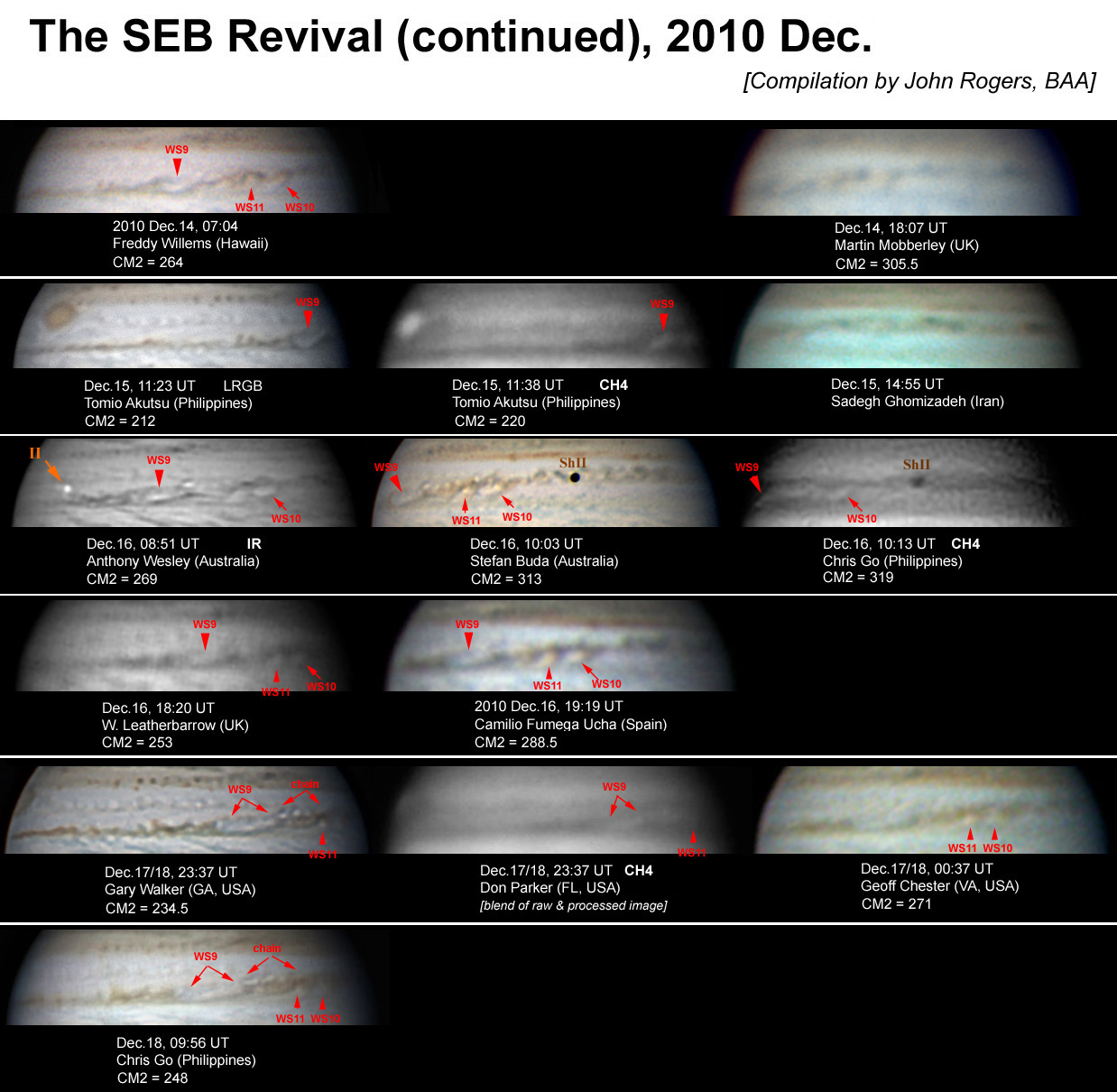| SEB Revival update by John H.Rogers |
SEB Revival update (Dec.22)
Greetings all,
Here is an update on the SEB Revival from Dec.3-18, presented in two compilations of images, plus some initial results from the JUPOS analysis. Congratulations to all the observers, who have provided the most thorough record ever obtained for such an event. Please take any opportunity to observe over the Christmas-New Year period, festivities and weather permitting, as the outbreak is now very extensive and dynamic, and frequent observations are needed to keep track of it.
Previously we have recorded brilliant plumes appearing at two locations: the original source (WS1, 2, 3, 7) and the leading edge of the central branch (WS-N, 4, 5, 6). Now, brilliant white plumes have continued to emerge in both locations: WS9 and smaller spots at the leading edge of the central branch, and WS10 at the original source. Two other white spots have arisen in between them (WS8, WS11).
The previous plume to appear at the source was WS7, on Dec.1. It was methane-bright on Dec.4, and visibly bright to Dec.6, but then suddenly disappeared. On Dec.7 a new bright spot appeared p. it (WS8: L2 = 286); but this only lasted to Dec.10.
Another very bright plume appeared at the source on Dec.10 (WS10: L2 = 298), methane-bright as usual (Dec.11 & 13). Then on Dec.13 another compact bright white spot appeared p. it (WS11: L2 = 288). WS11 was initially not methane-bright, but was slightly so on Dec.16 (along with an extended orange-brown strip p. it), and became brighter in both methane and visible light by Dec.17. The evidence suggests that WS8 and WS11 were weaker than those plumes which arose at the two principal locations, at least initially. WS8 only lasted for 3 days (there were no methane images in this interval), and WS11 was initially not methane-bright, although it became so later.
Meanwhile, in the broad diagonal band at the leading edge of the central branch, various transient small white spots continued to appear, and on Dec.8 one of these started to grow larger and brighter (here called WS9). By Dec.11 it was a very large 'bay' and methane-bright, and it seemed to eddy cyclonically to generate very dark bluish-grey oblique columns on both p. and f. sides. On Dec.14-18, WS9 elongated rapidly eastwards, still methane-bright, becoming a long oval which accelerated into the northern branch of the Revival - like WS-N before it. There were other, smaller white spots on the southern border of the leading edge - indeed, a chain of five on Dec.15, one of which then became very bright - but I have not numbered these.
The northern branch - a narrow dark segment of SEB(N) -- reached the GRS on Dec.11, and is continuing on past it. This preceding part has turned dark brown, but the slightly greenish tint persists further f., giving way to dark bluish or dark grey (and methane-dark) where it merges with the oblique dark streaks at the p. end of the central branch.
A reddish-brown colour is still seen within the central branch, but seems to be amorphous, adjacent to white spots, and methane-bright (Dec.16 & 17) - suggesting that it is perhaps a diffuse high-altitude aerosol emission, rather than a clearing in the clouds.
The JUPOS team have now completed their first package of measurements of spots in the Revival (Hans-Joerg Mettig, Michel Jacquesson, Gianluigi Adamoli, & Marco Vedovato). We can summarise the main preliminary results, although details are provisional; we will post the charts and more precise conclusions later.
The source and central branch have been analysed by Michel Jacquesson. The first three plumes at the source (WS1, 2, 3) all appeared on the same track as former barge B2, and in the same latitude (17.3 ± 0.2 deg.S). WS7 appeared slightly further north (15.8 deg.S). The plumes at the leading edge spanned a wide range of latitudes from 14.0 S (WS-N) to 19.4 S (WS4). Nevertheless, almost all these bright spots had drifts between DL2 = 0 and -18 deg/month (mean = -10 deg/month), with no correlation with latitude. The outbreak behaves as a coherent whole, not following the zonal gradient, except for those spots and streaks which break free into the northern or southern branches.
The southern branch erupted onto the SEBs which was already marked with a 'sawtooth' or 'wave' pattern, as described in our Report no.8. Since that report, this pattern had resumed its original speed at all longitudes, DL2 ~ +74 deg/month, with gaps moving at DL2 ~ +136 deg/month. The first dark spot on SEBs appeared to be a pre-existing projection which had been darkened on passing the Revival. The JUPOS chart confirms this, and shows that it accelerated immediately, around Dec.15, to DL2 = +132 deg/month (the peak jet speed) then settled down with DL2 = +117 (the typical speed for jetstream spots). Subsequent dark spots emerging from the Revival also have DL2 ~ +120. This behaviour is puzzling, because the dark spots of the southern branch still appear to be south of the usual jet peak, and do not appear to have formed into well-defined vortices yet; but it accords with our results in 2007, when the earliest spots in the southern branch were also unusually south for their retrograding speeds.
All best wishes for Christmas and the New Year.
John


John H. Rogers,Ph.D.
Jupiter Section Director,
[British Astronomical Association.]
●SEB復活の更新 (12月22日) これは12月3-18日のSEB復活の更新で、2つの組画像とJUPOS解析の最初の結果を示す。このような現象について最も完全な記録している観測者の皆さん、おめで とう。outbreakは今は非常に拡がって力強く、追跡するために頻繁な観測を必要とするので、催しや天候の許す限り、クリスマスや新年の間もできるだけの観測を お願いする。 以前、元の発生源(WS1, 2, 3, 7)と中央分枝の先端(WS-N, 4, 5, 6)の2箇所に、明るいプルームの出現を記録した。現在も明るいプルームは両方の場所で出現を 続けていて、中央分枝先端にWS9と小白斑が、元の発生源にWS10が出現した。他の2個の白斑がこれらの間に生じている(WS8, WS11)。 発生源に出現した以前のプルームは12月1日のWS7であった。これは12月4日にメタンブライトで、12月6日まで明らかに明るかったが、その後突然に消失した。12月7日 には、新しい白斑がその前方に出現した(WS8: L2 = 286)が、12月10日まで続いただけだった。 別の非常に明るいプルームが12月10日に発生源に出現し(WS10: L2 = 298)、通常のようにメタンブライトであった(12月11,13日)。その後12月13日には、別のコンパ クトな白斑がその前方に出現した(WS11: L2 = 288)。WS11は最初メタンブライトではなかったが、12月16日にわずかに明るく(その前方のオレンジ-茶色のstripと ともに)、12月17日までメタンでも可視光でも明るくなった。 証拠から、WS8とWS11は、少なくとも最初は、2個の主要な場所に発生するプルームより弱いことが示唆される。WS8だけが3日間続き(この期間にメタン画像はなかっ た)、WS11は最初メタンブライトではなかったが、後に明るくなった。 一方、中央分枝先端の広い斜めのバンドでは、様々な一時的な小白斑が出現し続けて、12月8日にはこれらの一つが大きく、そして明るく成長し始めた(ここではWS9と 呼ぶ)。12月11日までに白斑は非常に大きな"湾"になり、メタンブライトであり、前後端に非常に暗い青灰色の暗柱を形成するために、低気圧性の渦を巻いている ように思われる。12月14-18日には、WS9は急速に東方に伸びて、 まだメタンブライトであり、以前のWS-Nのように、復活の北分枝で加速した長い白斑になった。 先端の南境界には他の小さな白斑があり、確かに12月15日には5個のチェインがあり、その後その一つが明るくなったが、私は番号を振らなかった。 北分枝【SEB(N)の狭く暗いセグメント】は12月11日に大赤斑に到達し、大赤斑を通過し続けている。この前方部分は暗茶色に変わったが、さらに後方はわずかに 緑がかった色合いを保っていて、中央分枝の前端で斜めの暗いストリークとマージしている箇所は暗青色か暗灰色に変わっている。 赤茶色は今も中央分枝に見られるが、形がはっきりとしなくて、白斑に隣接していて、メタンブライトであると思われる(12月16,17日)。これは雲の晴れ間という よりは、おそらく拡散した高高度のエアロゾル放出であることを示唆している。 JUPOSチームは復活の斑点の最初の計測を完了した(Hans-Joerg Mettig, Michel Jacquesson, Gianluigi Adamoli, & Marco Vedovato)。詳細は暫定的であるけれども、 主要な予備的結果をサマリーすることができる。チャートやより正確な結果は後に公開できるだろう。 発生源と中央分枝はMichel Jacquessonによって解析されている。発生源の最初の3個のプルーム(WS1, 2, 3)は全て、以前のバージB2と同じ痕跡に、同じ緯度(南緯 17.3±0.2度)に出現した。WS7はわずかに北(南緯15.8度)に出現した。先端のプルームは、南緯14.0度(WS-N)から南緯19.4度(WS4)までの緯度の広い範囲に及んだ。 それにも関わらずに、これらの白斑のほとんどは、緯度との相関はなくて、DL2=0〜-18度/月(平均-10度/月)でドリフトした。北分枝および南分枝で解放された 斑点やストリークを除いて、outbreakは帯状流勾配に従わないで、首尾一貫した全体として振る舞っている。 南分枝は、我々のReport no.8に記述したように、"ノコギリ歯"あるいは"波"パターンとしてすでに名付けていたSEBsに出現した。そのレポート以来、このパターンは、 DL2=約+136度/月で移動するギャップを伴って、全ての経度で元の速度DL2=約+74度/月を再開した。SEBsの最初の暗斑は、復活を通り過ぎる時に暗化する既存のプロジェク ションであると思われる。これはJUPOSチャートによって確認されていて、12月15日頃にDL2=約+132度/月(ジェット気流のピーク速度)にすぐに加速し、その後 DL2=約+117度/月(ジェット気流斑点として典型的な速度)に落ち着いたことが分かった。復活から発生する続く暗斑もDL2=約+120度/月であった。南分枝の暗斑は 今も通常のジェット気流のピークの南に出現していて、まだ形のはっきりとした渦を形成するように見えないので、この振舞いは奇妙である。しかし、南分枝の初期 暗斑も後退速度として異常に南であったという、2007年の我々の結果と一致している。 良きクリスマスと新年を
John H. Rogers, Ph.D. Jupiter Section Director, British Astronomical Association 【日本語訳:伊賀祐一】 [British Astronomical Association.]
ALPO-Japan Latest
Jupiter Section